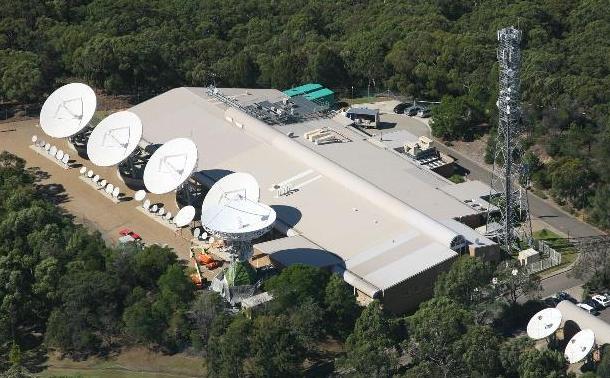
Credit: David Solomon
OVERVIEW
This page lists the major satellite ground stations on Australian soil at the time of writing (2012). They consist of a mixture of government, commercial and private. Australia hosts several facilities built and used by overseas governments and commercial firms.
OPTUS STATIONS
Optus is the prime supplier of Australian satellite communication and broadcast services, with a fleet of its own geosynchronous satellites. These satellites are supported by a ground network of four national and two international earth stations within Australia plus two offshore facilities. These stations provide continuous network monitoring, support and troubleshooting. Besides satellite tracking and data delivery, the stations also coordinate launch missions.
Link: Optus Earth Stations.
BELROSE NSW

Belrose is the key operations centre for Optus satellite services and controls the Optus satellite fleet. Belrose Satellite Operations comprises teams for satellite control, satellite support, satellite network management, VSAT operations and Earth station support. Belrose also provides launch support and consulting services for non-Optus satellites, whose global operations encompass Norway, Sweden, Malaysia, Indonesia, Thailand and Japan.
The site hosts a total of 44 antennae, 8 tracking and 36 fixed. It has 61 high power amplifiers for transmission.
LOCKRIDGE WA
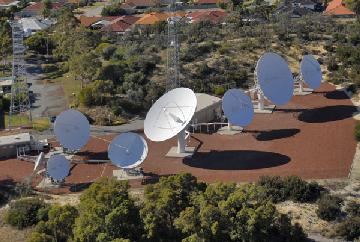 |
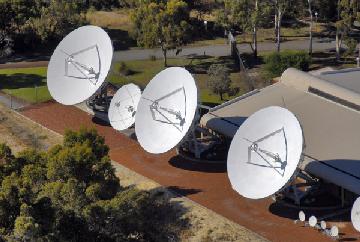 |
The Lockridge Earth Station supports international and domestic satellite services. It is continuously manned as a key Tracking, Telemetry & Control (TT&C) facility. It hosts 12 tracking and 10 fixed antennae.
HUME ACT
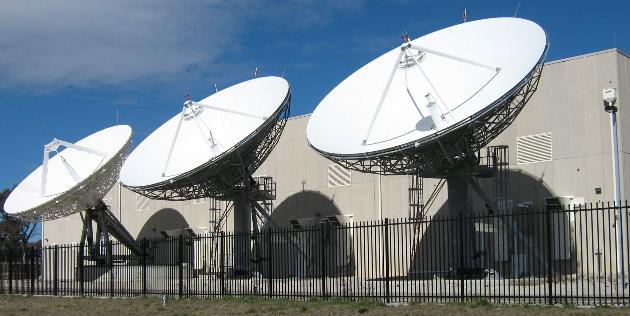
REGENCY PARK SA
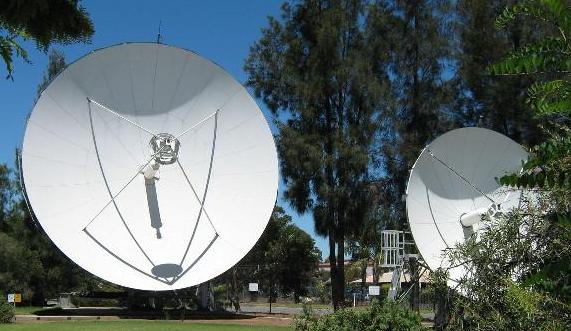
This site supports Intelsat with 1 tracking and 2 fixed antennae and serves as a backup TT&C site.
OXFORD FALLS NSW
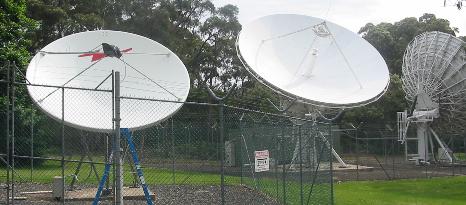
The Oxford Falls Earth Station is Optus' international gateway for voice, data and video services from international news gatherers as well as providing international communications for key Australian government departments and pay TV providers. The 8 antennas (4 tracking) at Oxford Falls are pointed to 2 Intelsat satellites, as well as New Skies and Asiasat satellites.
CANBERRA DEEP SPACE COMMUNICATION COMPLEX, TIDBINBILLA ACT
The CDSCC is one of the three NASA Deep Space Network (DSN) primary ground stations, the other two being in California USA and Spain. Their main function is to track, control, communicate with and download data from spacecraft well beyond Earth orbit. The station is currently run for NASA by the CSIRO Astronomy and Space Science (CASS) division.
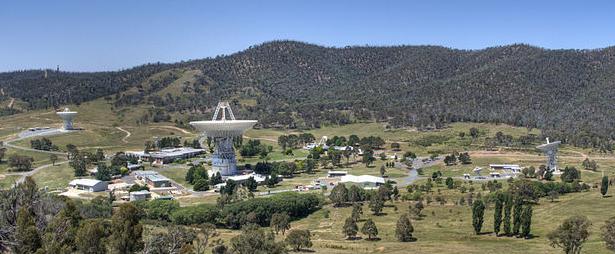
UNIVERSAL SPACE NETWORK, DONGARA WA
| This commercial satellite ground station at Dongara, about 60 km south of Geraldton, Western Australia is owned, operated and maintained by Universal Space Network (USN), a US based independent subsidiary of the Swedish company SSC. This station is one of four PrioraNet sites and is used primarily for communication with commercial Earth orbiting satellites, providing telemetry, tracking and control (TT&C) services. | 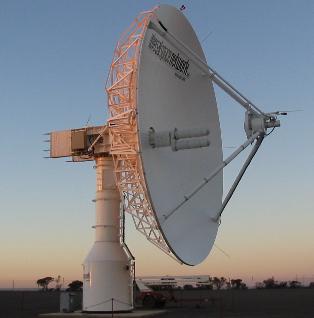 Credit: David Solomon |
NATIONAL EARTH OBSERVATION GROUP
The National Earth Observation Group (NEOG) of Geoscience Australia, was formerly known as the Australian Centre for Remote Sensing (ACRES). It has a Data Acquisition Facility (DAF) in Alice Springs and a Data Processing Facility (DPF) in Canberra. The DPF also processes data from the Tasmanian Earth Resources Satellite Station (TERSS) located at the University of Tasmania site on Droughty Hill, 10 km from Hobart.
DAF, ALICE SPRINGS NT
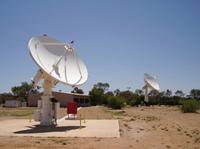 Credit:Geoscience Australia |
This Data Acquisition Facility of NEOG/ACRES tracks multiple earth resources satellites, downloading the S and X - band data for processing by the DPF in Canberra. |
TERSS, HOBART TASMANIA
| TERSS is the Tasmanian Earth Resources Satellite Station, a collaborative project which involved several major Australian organisations in the initial design and building of Australia's second Earth resources satellite ground station. Data is processed at the DPF in Canberra. |  Credit: TERSS |
LOCKHEED MARTIN, URALLA NSW
Lockheed Martin Australia owns and operates this Earth station to provide telemetry, tracking and command services for a wide range of customers. The station is located in the New England region of New South Wales, south of Armadale.
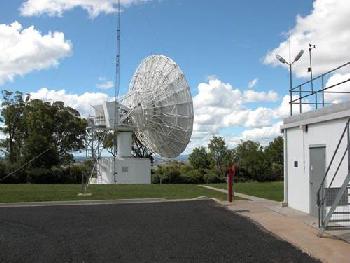 |
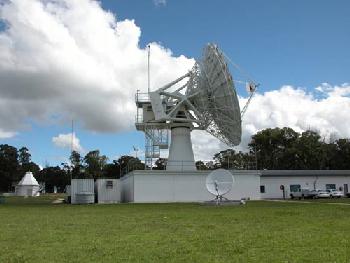 |
NEWSAT TELEPORTS
NewSat is Australia's largest specialist satellite communications company, delivering Internet, voice, data and video communications via satellite. It has two ground stations, one in Adelaide and one in Perth, which provide services to commercial, government and military customers from Australia and overseas. It hopes to launch a fleet of its own Ka-band geosynchronous satellites under the name 'Jabiru'.
MAWSON LAKES SA

12 antennas from 2.4 to 13 m in diameter, with C and Ku - band capabilities to 12 geosynchronous satellites.
BASSENDEAN WA
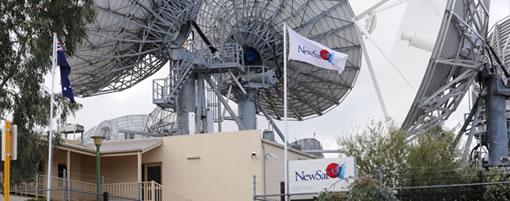
11 antennas from 2.4 to 13 m in diameter, with C and Ku - band capabilities to 9 geosynchronous satellites.
BUREAU OF METEOROLOGY
The Australian Bureau of Meteorology maintains several downlink stations around Australia and in the Antarctic to receive meteorological data and images from geosynchronous and polar orbiting satellites belonging to the USA, Japan, China and Europe.
Each reception site consists of one or more satellite antennas that receive data either in L-band or X-band. The signals are processed by on-site computers and the ingested satellite data is distributed around Australia and internationally.
MELBOURNE, VICTORIA
CRIB POINT, VICTORIA
SYDNEY, NSW
WASTAC, PERTH WA
| Western Australian Satellite Technology and Applications Consortium is comprised of state and federal departments and universities whose main objective is to collect and maintain a reliable, comprehensive and accessible archive of environmental satellite data. It runs two satellite earth stations, an L-band receiver at Curtin University of Technology and an L and X - band station at Murdoch University. Data ingest and display facilities at located at the Bureau office in West Perth. | 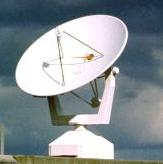 |
DARWIN, NT
CASEY, ANTARCTICA
ESA DEEP SPACE EARTH STATION, NEW NORCIA WA
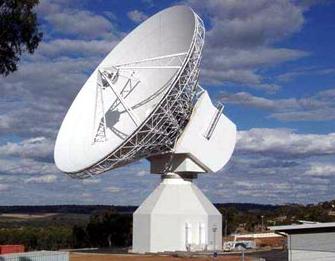 Credit: ESA/ESOC |
This European Space Agency station, DSA 1 (Deep Space Antenna 1), hosts a 35-metre deep-space antenna with transmission and reception in both S and X-band and is located 140 kilometres north of Perth, Western Australia, close to the town of New Norcia. DSA-1 is designed for deep-space satellite missions (beyond Earth orbit), and performs telemetry, tracking and command (TT&C) functions.
DSA-1 hosts uplink and downlink equipment (with Ka-band a future addition), a ranging system, a frequency and timing system, a monitoring and control system and a communications system. The site is highly automated with few personnel and control originating from Darmstadt in Germany. |
CSIRO, PARKES NSW
| This CSIRO facility at Parkes in central New South Wales is primarily a radio telescope, but is occasionally used as part of the NASA Deep Space Network, either alone or in conjunction with the Canberra Deep Space Communication Complex. | 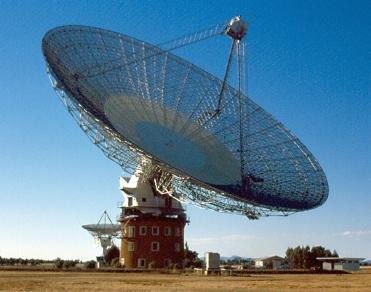 Credit: CASS |
ADSCS, KOJARENA WA
The Australian Defence Space Communication Station (ADSCS), located at Kojarena, 30 km to the east of Geraldton in Western Australia, is primarily a signals intelligence facility, monitoring communication traffic carried by (geosynchronous) satellites stationed over the Indian Ocean and to the northeast of the site. It is operated by the Australian Defence Signals Directorate, and probably monitors L, S, C, X and K band traffic. A recent independent addition is a US Defense MUOS (Mobile User Objective System) ground station, to provide narrow-band mobile UHF communications for the US and Australian militaries.
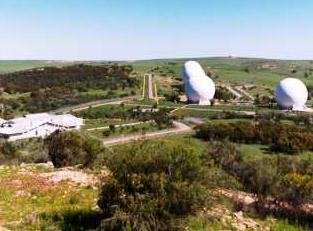 |
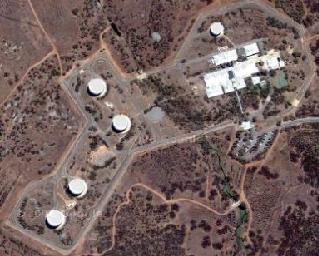 Credit: Google Earth |
 Australian Space Academy
Australian Space Academy